Hi Chuck and Sandra,
It's been too long since I've written an article for Duckworks, though I've had a couple projects I think are interesting. I've been spending a lot of time on the water and less on the computer.
Here's an account of a boat I built in January, '07 and have had a lot of fun with. The construction is a bit different as it combines 3mm okoume plywood, 1/2" balsa core, and pink styrofoam, with, of course, epoxy and fiberglass.
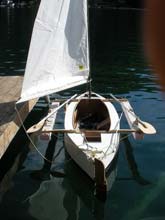 |
This picture shows the final version, which is focused on rowing and sailing. |
I wanted a boat light enough to cartop, yet big enough to sleep in. I was partly inspired by seeing what can be done in a short length by Matt Leyden's Enigma. I wanted to incorporate the Hobie Mirage drive too. In fact, the origninal idea was for a pure pedal boat. Things evolved from there, as the boat took on a life of it's own. I went with the dead flat floor/bottom as used in Bufflehead to give a good sleeping area which is just 6' long, and is 28" wide at the widest. Boxy Lady is 12' x 3' x 16" deep.
CONSTRUCTION
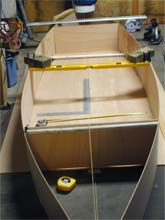 |
The first step was to cut the 16" high side pieces and connect them with butt blocks into full lengths. The ends were stitched together and the sides set up and spread apart with the two bulkheads. The bottom of the cockpit area was cut to fit the curve of the sides. |
| Then 4" strips were cut off of the bottom edge of the side pieces and the edges of the bottom piece. These two pieces formed a notch in the chine area. The bulkheads and ends were then glassed with tape and the hull turned over so the inner corner of the notch could be glassed. This picture shows the bottom of the boat without the bottom ply in place. |
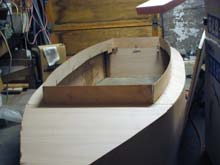 |
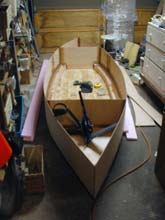 |
Then it was turned upright again so the bottom 3mm piece in the cockpit area could be glassed in and the 1/2" balsa core epoxied to it and glassed over with one layer of 6 oz glass. The Mirage drive is sitting where the well will be installed. |
| The the hull was turned back over and the 4" thick pink styrofoam added a bit oversized. |
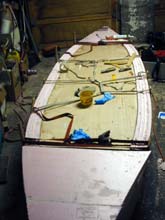 |
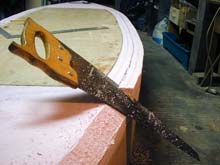 |
After levelling the foam to be even with the ply bottom and the hull sides the next step was to cut a 45* angle to begin the chine shaping. |
| The chine was then rounded off with Surform plane and sandpaper |
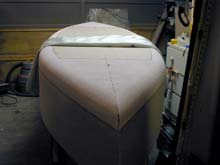 |
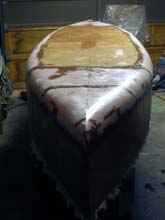 |
and glassed with 6 oz glass which covers the entire exterior. |
| The bottom of a previously built Mirage pedal drive well was recycled. The four notches hold the drive in place in the well built on this base. |
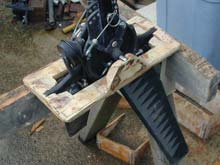 |
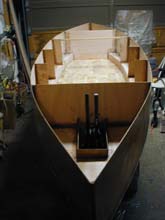 |
4" wide strips of 3mm ply were glassed in the cockpit to form storage bins and stiffen the 3mm hull sides. The Mirage drive well was inserted through the foam in the stern compartment with the idea of having a remote pedal system to leave the cockpit area open for sleeping. Since the boat draws only 3" to 4" the end compartments are self-draining. |
| Inner sides were added to the compartment dividers to form little storage compartments and stiffen the hull. Also if the 3mm hull should be holed the water would be limited to a compartment and not flood the cockpit. |
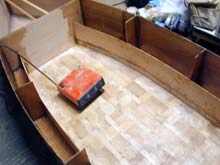 |
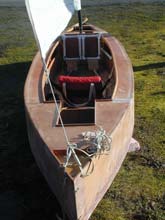 |
Decks and hatches and a small coaming around the cockpit were added to finish off the hull. The remote pedal system consisted of swinging pedals and lines routed around the sides of the cockpit back to the Mirage drive pedals. I made a fiberglass tube around the mast, a reduced diameter windsurfing mast, and glassed it in the bow area to allow using the dinghy rig that I already had for the Stoaproa. |
PEDALLING, ROWING, SAILING, AND CAMPING
| The bare empty boat came out at just 55 lbs but is awkward to carry and had more weight added with equipment that is left in the boat. So I made a little beach dolly to help get it from the car to the water. The wheels are from a golf bag cart bought at a thrift store, and it comes apart to be carried onboard and stored in an end compartment. |
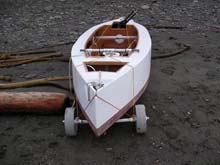 |
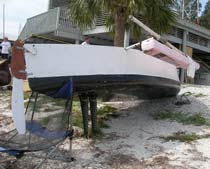 |
On the beach at the Small Boat Festival in Sarasota, Florida, spring 2007. I had discovered that I could only get up to 3.5 knots with the pedal unit but could row more easily at that speed and reach 4 knots with effort. So I added sponsons for sailing safety and also to give a 5' wide spread for the oarlocks. I eventually abandoned the pedalling because it was too complicated and inefficient in the linkage, in favor of sailing and rowing. I glassed over the box, but left it in place. The bottom is coated with epoxy with graphite powder filler. |
| Camping on the beach near Port Townsend, Washington. I removed the sponsons to make it easier to reach in for things. I slept in the boat rather than on the beach. At high tide in the middle of the night I was invaded by hundreds of sand fleas that landed in the boat and couldn't get out. I had to cover my head to get some sleep the rest of the night while they hopped all over me. The next time I camped here I slept on the sand. I've also slept aboard at anchor with my 2 kg. Bruce anchor. |
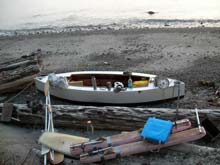 |
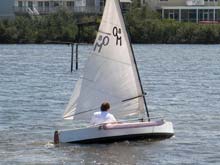 |
I started with slide in sponsons, but eventually made a swing-in system that is stronger and easier to use. A sponson can quickly be folded for coming alongside a dock, and both are in the folded position when I put it on the roof top rack. When overpowered in a sudden gust the sponson provides enough reserve buoyancy to give me time to react. |
| My son enjoyed sailing the boat in Florida when I was there in 2007. Although it has been sailed with one crew onboard, it is pretty crowded and I just use it as a singlehander. It has a dagger/leeboard for lateral resistance and eventually ended up with a larger rudder for sailing, the originall being made more for steering while pedalling. The sprit boom is half of an old windsurfer boom. The oars are always in the oarlocks and ready to deploy. |
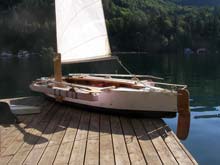 |
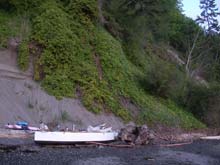 |
I've had a lot of fun with Boxy Lady the last couple years rowing and sailing and am now going to try the remote pedal set up again, but with rigid connections to the pedals with the boat facing the other way. The Mirage drive will be in the bow rather than the original version with it in the stern. If this works out I will move the mast and rudder to opposite ends so I can pedal-sail. The ends of the hull are identical in shape. |
Gary Lepak
Port Angeles, Washington
***** |

